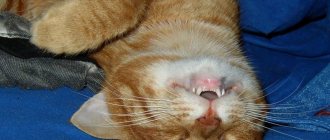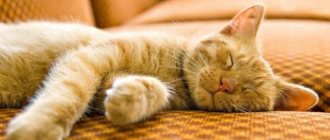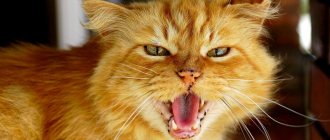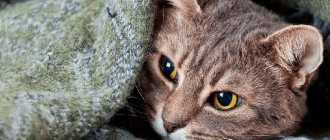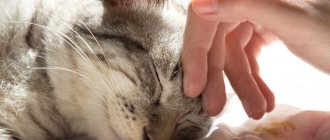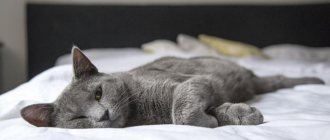Seizures are characterized by sudden bursts of uncontrollable muscle activity, often described as seizures or convulsions. They are caused by a temporary disruption of normal brain functions.
The attacks can last a few seconds or minutes, and sometimes last for hours.
Single cases are associated with metabolic disorders, head trauma, low blood sugar (hypoglycemia), high fever, and ingestion of toxins. Repeated seizures may be a sign of epilepsy or other serious illnesses.
Seizures associated with epilepsy may occur at regular or irregular intervals ranging from days, months or even years.
What do cramps look like?
The most crucial point in diagnosis is the timely detection of seizures, which may look like this:
- Single muscle and fascial twitching. Most often, such symptoms can be observed while the pet is sleeping.
- Widespread cramps that involve the entire torso.
At the same time, the second group is divided into several subtypes:
- Convulsions. The cat remains fully conscious, but multiple twitching of the muscles of the limbs, tail, and muscle fibers on the face are visually detected.
- Tonic convulsions, in which the torso straightens, like a string. As a rule, such an attack is accompanied by loss of consciousness.
- Clonic seizures are characterized by small, numerous twitching of various muscle groups. In a photo or video of a cat’s seizures, you can notice a certain cyclical pattern of seizures. The contractions are chaotic, but occur at regular intervals.
There are also combined tonic and clonic convulsions, in which in the first phase there is tonic tension of the entire body.
The first phase is quickly replaced by the second, during which small fascial and muscle fibrillations occur.
Sometimes it is possible to recognize the so-called aura or a period of precursors, during which the pet begins to behave unusually, meow loudly, and run restlessly around the apartment (if this is not typical for the cat in its normal state).
Why might a cat tremble after sterilization?
There can be many reasons for trembling and these will be discussed further.
After all, the most important thing in this situation is to be able to understand the reasons for the appearance of this symptom.
It is also important to understand at what point you should seek help.
The process of recovery from anesthesia
The cat will have poor coordination and may experience tremors. This is a normal reaction to medications. Usually such trembling does not last long and does not carry anything bad.
Advice!
Observe your pet, do not leave her alone and monitor all changes occurring in her condition. If everything is in order, then after a while the trembling will pass.
Frozen
Cats are very warm-blooded animals and the optimal room temperature for them is about 20 degrees. All cats tremble even after the usual, not to mention any temperature changes.
As you know, body temperature decreases during sleep. The same thing happens while under anesthesia, that is, the cat may simply freeze, which will provoke trembling.
Advice!
To prevent this from happening, you need to place your pet next to a warm radiator or place a heating pad near it. You can try to cover your pet with a warm blanket, but most likely this will not be successful, because animals behave very restlessly when they come out of anesthesia.
The blanket is in the way
Some animals do not perceive any foreign objects on their bodies. One of these (foreign to the animal) things is the one that is worn after the sterilization procedure.
By trembling, the animal may try to remove the blanket and thereby relieve itself of discomfort.
Attention!
Some cats shake when they are stressed, and the cause of discomfort may be the same blanket.
In this case, you can try to wait until the cat calms down or consult a veterinarian about removing the blanket for a short period of time. If the doctor approves this step, then it is important to ensure that the cat does not dirty or lick it in any way. At this time, you need to keep an eye on your pet.
Why does the animal run and nervously lick itself?
Licking is normal for cats. These clean animals are so sensitive to the cleanliness of their fur that they lick themselves at every opportunity: after eating, going to the toilet, or being touched by their owners. Moreover, by licking their fur coat, they calm down. Licking can be talked about as a normal phenomenon only when it is not fanatical in nature. Why does a kitten or adult cat run around the house and lick nervously?
The cat is stressed
These animals have a very vulnerable psyche. It doesn’t take much for a pet to lose its peace of mind. This can happen due to a trip in a car, a visit to the veterinarian, quarrels in the family, the appearance of a new four-legged inhabitant in the house, moving to another room, changing place of residence, etc. All cats experience stress differently. Some begin to run aimlessly around the apartment and fanatically lick the fur. Sometimes they do this so violently that in some areas of their bodies they become completely bald.
As soon as the factor that provoked the cat’s emotional shock disappears or he gets used to new circumstances, the pet will stop being nervous. However, cats are not always able to overcome stress on their own. Sometimes they need sedatives.
Hyperesthesia syndrome
This rather rare disorder, affecting the skin, neuromuscular and nervous systems, is most often detected in kittens. The reasons for its appearance are unknown, but it is believed to be due to disruption of neurotransmitters in the brain during anxiety.
Animals with this syndrome feel tense all the time and experience increased sensitivity to touch. Their spine and tail are the most vulnerable. They lick the fur too diligently, paying special attention to the most vulnerable areas of the body, sometimes leading to the appearance of bloody wounds. Hyperesthesia syndrome can also be recognized by other symptoms:
- nervous tail beating;
- twitching of parts of the body in the back;
- sudden bursts of activity, sometimes developing into aggression;
- dilated pupils;
- tail biting;
- loud meow.
The cat has fleas, worms or other parasites
The reason for this behavior may be ecto- and endoparasites. They cause the pet a lot of suffering. Especially unbearable for them is the endless itching in places affected by external parasites, such as fleas. It prevents the tailed poor fellows from sleeping peacefully, eating, and spending time carefree. In order to somehow drown it out, they begin to rush around the house and actively lick the irritated skin, often only aggravating the situation.
Having noticed symptoms of a helminthic infestation in a cat, it is necessary to take measures to destroy the pests as quickly as possible. Antiparasitic drugs, especially if they are planned to be used to treat a kitten, should be discussed with your veterinarian.
This is interesting: Instructions for use of the drug Nobivak Rabies for cats
Other reasons
There are other factors that do not fit into the structure of known groups. They are also dangerous and can cause death.
Postoperative period
Surgical interventions are accompanied by the administration of painkillers, anesthesia and other medications to the animal. If the operation was performed incorrectly or the dosage was incorrectly selected, the body may react to this with convulsions.
When prescribing medications, the doctor must take into account their individual intolerance.
Epilepsy
A systemic disease associated with changes in brain activity is always difficult, with severe, painful seizures and can result in the death of the pet at any time.
The pathology can be hereditary or develops against the background of trauma, inflammation of the membranes of the brain, or cancer.
Stress
Convulsive contractions are short-term in nature, accompanied by aggressive behavior and lack of appetite. This is due to strong stimulation of the nervous system after experiencing emotional shocks.
A cat can be stressed by bathing, moving, or the arrival of a new animal or small child in the house. In uncastrated pets, seizures may begin due to unsatisfied sexual instinct.
Rules for taking anticonvulsants in veterinary medicine
When a veterinarian prescribes anticonvulsants, you must adhere to the established rules:
- The dose and schedule for taking the medicine must be strictly established; chaotic use is not allowed.
- You should not spontaneously stop treating your cat - this can lead to stronger seizures.
- If the drug runs out, you need to worry about buying a new package in advance. If the medicine is given on a prescription, you must notify your veterinarian.
- The product must be stored in a safe place, out of reach of animals or children.
- You need to consult a veterinarian about compatibility with other drugs, if there is a need for supplements.
The first cerebral symptoms of a tumor
When the second stage of the disease develops, the meninges are excited and intracranial pressure increases. As a result, cerebral changes occur.
The tumor puts pressure on the brain, affecting its functioning.
At this time, the treatment is still successful, but it takes longer and is more difficult. The symptoms of the second stage are no longer so easily confused with the symptoms of other diseases:
- sensitivity is lost in certain areas of the body;
- sudden dizziness occurs;
- muscles weaken, often on one side of the body;
- severe fatigue and drowsiness sets in;
- seeing double.
At the same time, my general health deteriorates and morning sickness continues. All this manifests itself in the patient regardless of what part of the brain the tumor is located in.
However, it is still possible to confuse the symptoms - they are approximately the same as with epilepsy, neuropathy or hypotension. So if you find yourself with these symptoms, do not rush to panic. But be sure to go to the doctor - the unknown has never been good for anyone. And such symptoms should not be joked about.
What is epilepsy and how often does it develop in cats?
Epilepsy (from ancient Greek - seized, caught) is a neurological disease that occurs as a result of disruption of the normal functioning of the pet’s brain. The disease can manifest itself as convulsive twitching of individual parts of the animal’s body, loss of consciousness with convulsions, or loss of orientation in space.
Read also: What to do if a child eats sand
The disease rarely affects cats, the prevalence of the pathology is only 0.5–1%. There is an opinion that epilepsy develops more often in purebred animals, but there is no scientific confirmation of this fact. According to statistics, the pathology affects male animals to a greater extent, cats suffer less often. The disease is not related to the age of the pet and can appear at any period of life.
Symptoms of seizures
Many people are probably familiar with the sensation that is caused by a muscle cramp, and at the same time there is a sharp pain. Cats experience similar sensations with muscle cramps. Visually, chaotic movements made by the paws are visible. Sometimes the opposite happens, and the pet lies on its side with tense paws curled under its stomach and clenched fingers.
The cat at this moment is very scared, screaming in pain, but does not allow the owner to touch him. During moments of convulsions, the cat’s pupils are dilated, and the whiskers are pressed tightly to the muzzle or become bristling.
If there are cramps in the hind legs, the pet may fall and the legs may be pulled in length. During a seizure, the cat may try to get up, but he will not be able to do it. But that rarely happens. Most often he is afraid to even move. In the most severe cases, the cat may urinate voluntarily and foam from the mouth. The animal does not recognize the owner, and therefore does not respond to his call. Sometimes the cat behaves aggressively.
But when the convulsions end, the pet, having calmed down, will behave as before. Although in some cases, for a short period of time, he may not find his usual places and may not even recognize his home.
Unfortunately, there are owners who, seeing their pet in this condition for the first time, do not rush to seek help from a skilled veterinarian, but wait until the seizures recur. This behavior is irresponsible, since seizures may indicate that the cat has developed a serious, and often life-threatening, illness, and when repeated seizures occur, time may already be lost.
It is very important not to make this mistake and bring your pet to the veterinarian even if after an attack of seizures he looks healthy and as cheerful as always.
Seizures in cats vary and may be accompanied by additional symptoms in different situations.
Your pet has seizures and twitching hind legs
Such convulsions occur in cases where there is a lack of a substance in the cat’s body or an excess of it. Similar conditions, with the exception of poisoning, for example, with pesticides, most often occur in elderly, pregnant, lactating, or malnourished animals. In more rare cases, such seizures may signal a stroke.
Cramps and drooling
Convulsions, which also cause drooling, may indicate the most terrible diagnosis for a cat - rabies. It is impossible to save a cat if it is already sick. He is immediately quarantined and restricted from any contact. In addition to cramps and drooling, it is necessary to carefully monitor other signs indicating the occurrence of the disease.
Cramps and foam at the mouth
Convulsions in a cat, accompanied by foam from the mouth, occur during an attack of epilepsy. But there are other reasons for this condition - kidney and liver diseases, hepatic encephalopathy, endotoxicosis, hypoglycemia.
Seizures of epilepsy with convulsions and foam at the mouth may indicate brain tumors, ischemic encephalopathy, and rarely post-traumatic or post-infarction conditions.
Cramps in a cat's hind legs while sleeping
Sometimes a cat has convulsions in his sleep. They can scare its owner. The pet is sleeping, but its eyelids, whiskers and lips are twitching, its paws, both front and back, tremble finely and often. You can hear the cat's loud meow or purr. In most cases
Such convulsions in a cat’s sleep are only a sign that he is having exciting dreams. But if he suddenly jumps up at the moment of convulsions during sleep, looks around restlessly, and then for a long time he cannot find a place for himself, then you need to sound the alarm and take the cat to the veterinarian.
Convulsions in a cat before death
In many cases, in cats, like in any other animal, the death throes are accompanied by convulsions. This condition may indicate approaching clinical death. Unfortunately, even if the course of treatment is carried out correctly, many diseases that are accompanied by seizures lead to the death of the cat. Therefore, if the veterinarian claims that your pet no longer has a single chance of recovery, you should not wait for the onset of painful and prolonged death throes. It is better not to cause him unnecessary suffering and, although it is very painful for the owner, to euthanize the animal.
Possible cat diseases accompanied by seizures
In most cases, seizures occur when the animal has epilepsy. But, there are other ailments in which muscle spasms are observed.
Among these diseases are:
- metabolic failure in the body;
- a brain tumor;
- severe poisoning of the body.
Often, seizures are a consequence of complications of various kinds of infectious diseases, such as toxoplasmosis or fungal tissue infections. There are many diseases of the central nervous system accompanied by brain damage.
Polycystic kidney disease in cats - causes, diagnosis and symptoms of the disease. Treatment options and prevention of kidney disease (95 photos)Tartar in cats - signs of the disease and methods of fully treating tartar (125 photos + video)
Ascites in cats - first causes, treatment, symptoms and step-by-step description of the development of the disease (105 photos)
Seizures can occur when there is a deficiency of glucose in the blood. They appear as a result of a long course of liver disease.
A low concentration of calcium in a cat's body may be the basis for the onset of seizures. A disease called hypocalcemia often begins along with renal and endocrine diseases.
A lot of reasons can lead to an attack of convulsions, ranging from poisoning of the body with various groups of substances and ending with intestinal parasitic diseases.
It is possible that a cat may begin to have seizures due to thyroid disease. From the entire list above, it becomes clear why a cat may experience seizures.
First aid: owner actions
In such situations, a person’s self-control plays an important role. Timely measures taken will help save the life of a pet:
- During an attack, the cat must be carefully laid on a flat surface, which is covered with oilcloth or rags. At the same time, you cannot forcibly hold it, so as not to provoke unnecessary stress. You should not unclench your jaws, so as not to injure the animal.
During an attack, it is recommended to administer an anticonvulsant and analgesic to your pet. They do this by injection, and not by mouth: convulsions that seize the muscles of the larynx will not allow the cat to swallow the medicine, and it will simply choke.- A light massage will help ease the spasm. It is carried out on areas of the body affected by convulsions.
Even a small isolated attack is already a reason to urgently take your pet for examination. Convulsive muscle contractions don’t just happen. There needs to be a reason for this, and each of them is dangerous.
Treatment and supportive care
Epilepsy in cats can be treated at home. With the acquired variety, therapy is based on eliminating the root cause. If convulsions are observed frequently, then the animal must be prescribed anticonvulsants. In milder cases, sedatives are sufficient to relax the body.
In addition to taking medications, proper nutrition plays an important role. The easiest way is to switch your pet to ready-made food for epileptic cats. Most of its composition comes from proteins, and a smaller part from grains and other carbohydrates.
What can nocturnal epilepsy be confused with?
Sleep disorders similar to sleep epilepsy:
- Parasomnias (somnambulism, night terrors, waking up with confusion).
- Rhythmic motor acts during sleep (benign sleep myoclonus, involuntary movements of the limbs, bruxism = teeth grinding).
- Enuresis (bedwetting).
- Disturbance of the breathing rhythm during sleep (sleep apnea, including physiological apnea in children, obstructive apnea in adults).
- Movements during rapid eye movement sleep.
- Automatisms in sleep (swinging, yactation).
- Nocturnal “paralysis” (or nocturnal “intoxication”).
The importance of REM sleep in kittens
Kittens are able to dream while still inside the mother cat. Moreover, REM sleep provides neural stimulation, which contributes to the normal development of the brain and the entire nervous system of the embryo. The REM phase is extremely important for newborns and growing animals. Young animals experience dreams especially vividly. Kitty:
- can move its paws;
- beat the tail on the floor;
- roll over from side to side;
- move your ears and cheek muscles;
- breathe rapidly and meow.
Especially often, such violent reactions appear after outdoor games, stress or hunting experience. Running and tired, the baby may fall asleep in an unnatural position with his eyes half-open, which also should not cause concern. Firstly, kittens are like human babies and relax in their sleep without feeling discomfort, and secondly, the presence of a third eyelid in the corner of the eye helps protect the eyeball from drying out.
Features of the nervous system in kittens. The nervous system is formed simultaneously with the growth of the body, so unusual motor activity in kittens in the REM phase is completely normal.
If in adult animals the duration of REM sleep is 15-20 minutes, followed by a longer phase of slow-wave sleep, then in kittens up to six months the REM phase takes up 80% of the total rest time.
If the owner noted that the growing furry pet began to sleep more calmly and practically does not flinch in its sleep, then we can talk about the animal growing up and strengthening the nervous system. The period of stabilization of nervous functions is very individual and is determined by many factors, such as:
- Breed affiliation . In outbred cats, which generally mature faster, psychological maturation begins by 12 months, and representatives of large breeds, growing up to 2-2.5 years, demonstrate elements of childish behavior for quite a long time.
- Character . Temperamental and easily excitable animals require more time for the development of nervous processes than balanced and calm phlegmatic animals.
- Personal negative experiences and traumas . Stress can cause serious damage to the psyche. It has been proven that animals that have experienced fear and pain can return to this episode in their sleep, experiencing real nightmares.
Also watch the video why a cat twitches in its sleep:
Treatment at the Energy of Health clinic
Doctors at the Energy of Health clinic will always come to the aid of patients with intercostal neuralgia. We offer each client:
- a full examination with consultations with specialists for an accurate diagnosis;
- individual selection of treatment regimen;
- services of a qualified chiropractor;
- own exercise therapy room for the most effective and safe exercises;
- modern methods of physiotherapy;
- massotherapy;
- drug blockades for severe pain syndrome.
Regular observation by a neurologist after the acute period of the disease has subsided will help prevent recurrent attacks.
Forms
There is no special classification of the disease. There are several separate forms depending on the mechanism of occurrence:
- radicular: associated with irritation of the spinal cord roots at the point of their exit from the spinal column;
- reflex: associated with overstrain of muscle fibers at the site of the nerve passage.
There is also a classification of neuralgia depending on:
- causes: primary (associated with damage or inflammation of the nerve itself) and secondary (due to other diseases);
- localization: unilateral and bilateral;
- course of the disease: acute and chronic.
Cats at risk
Although epilepsy can occur in any cat, it most often affects:
- animals with a similar disease in their pedigree;
- kittens whose mothers suffered a serious illness during pregnancy;
- kittens obtained from close relatives;
- survivors of chemical poisoning;
- have had infections, often with complications;
- cats that have been injured or stressed during pregnancy.
There is no age interval for the onset of the disease - seizures occur in kittens and adult cats.
Read also: Headscarf and scarf for the beach
Preventive measures
Prevention will help you avoid problems related to your pet’s health:
- diet with the selection of balanced feeds;
immunization and deworming of the animal;- regular treatment against parasites;
- timely treatment of infectious diseases.
Preventive visits to the veterinarian 1-2 times a year will help to promptly identify and eliminate diseases of internal organs and systems.
Diagnosis of suspected brain tumor
Even a general or biochemical blood test can indirectly indicate the presence of a tumor. However, if there is a suspicion of a neoplasm, more accurate tests and studies are prescribed:
- electroencephalography will show the presence of tumors and foci of convulsive activity of the cerebral cortex;
- MRI of the brain will show foci of inflammation, the condition of blood vessels and the smallest structural changes in the brain;
- A CT scan of the brain, especially with the use of contrast fluid, will help determine the boundaries of the lesion;
- analysis of cerebrospinal fluid - fluid from the ventricles of the brain - will show the amount of protein, cell composition and acidity;
- examination of the cerebrospinal fluid for the presence of cancer cells;
- A biopsy of the tumor will help determine whether it is benign or malignant.
Types of epileptic seizures
There are several types of epileptic seizures, but one should not assume that the same type will be exactly the same in different animals. In particular, seizures, regardless of their type, almost always involve the development of convulsive spasms of the limbs. Almost, but not always. Some cats do not experience convulsions. As for the duration, the “classic” of epilepsy is considered to be a short, fleeting seizure that lasts for a maximum of a minute. Again, in some cats the duration of attacks can be up to five minutes, even when the disease is not advanced. Due to the short duration, many owners may not even notice that something is wrong . In general, there is a very common misconception that cats with epilepsy will inevitably injure themselves during seizures. So here it is. This is truly a misconception. In just a few seconds of convulsive twitching, nothing outwardly will happen to the animal. Only his brain will suffer, which after some time will certainly manifest itself in the form of more frequent seizures.
Now we will look at the main varieties of the latter. Please note that the classification we have given is approximate; the boundaries of different types can be extremely blurry.
Localized seizures
They develop only when a small part of the cerebral cortex is affected. With localized seizures (if you start treating your pet in time, of course), there is hope for lifelong remission and maintaining the proper level of quality of life for the animal.
They appear as follows:
- Episodic movements. A classic example is convulsive twitching of the facial muscles, constant and “inappropriate” blinking. Cases have been described in which a cat’s head or one of its limbs “chronically” twitched.
- Signs of uncontrolled behavior of the autonomic nervous system are also characteristic. Simply put, cats with this type of seizure often exhibit excessive drooling, vomiting, and dilated pupils.
- Severe behavioral abnormalities are often observed. You may notice, for example, restlessness, anxiety, the cat constantly runs after other animals and people, and has panic attacks.
Generalized (generalized) seizures
Such attacks do not bode well for the animal, as they indicate serious damage to large areas of the cerebral cortex. Only in very rare cases do generalized seizures appear in an animal right away. Much more often, they are only a consequence of a gradual deterioration of the course of the disease, i.e. At first, a localized variety is observed in the pet. The main sign of a generalized seizure is loss of consciousness and a sharp increase in salivation. There are cases of involuntary defecation and urination. As a rule, the cat falls, the limbs on both sides of the body twitch convulsively and randomly. Separately, it is necessary to describe the characteristics of seizures that develop in these cases. They are tonic, clonic, mixed and myoclonic.
Let's briefly look at each variety:
- Tonic convulsions. The muscles tense sharply, this lasts from several seconds to several minutes.
- Clonic variety. Manifested by rapid and rhythmic muscle contractions.
- Mixed convulsions. First, the muscles contract with a tonic spasm, which after a while is replaced by clonic contractions.
- Myoclonic seizure epilepsy in cats. Similar to tonic, but characterized by sharp, sporadic contractions of the limbs. Often the spasms first cause the paws on one side of the body to clench and relax, after which they quickly move to the other.
But! In approximately 30% of cases, seizures are nonconvulsive. They are characterized by atonic attacks.
The cat's muscles suddenly lose rigidity, causing the animal to fall. If you feel the muscle tissue during a seizure, it will feel like liquid jelly. This condition is extremely dangerous, since if the attack lasts long enough, your pet may suffocate (the respiratory muscles also become relaxed).
Transitional varieties
In such cases, generalized and localized seizures alternate in different proportions. It is believed that these seizures are most common in cats with epilepsy. They proceed quickly, and at first even the animal itself (due to partial shutdown of brain functions) does not have time to understand what exactly happened to it. In addition, sometimes they happen in a dream. As a rule, all transitional types have clearly defined “triggers”, to identify which the animal should be carefully observed.
Seizures in a cat: how to provide first aid
The owner of a sick cat must be on alert, because the paroxysm begins suddenly. The main task is to avoid injury during convulsions. The cat is placed on the floor, turned on its side, and covered with soft cloth. In this position, her tongue will not stick into her larynx during a seizure. They sit down next to each other and place their hand on the pet’s head. The tip of a teaspoon is inserted between the teeth to prevent the kitty from biting her lip.
All observations about the pet's behavior during an attack are recorded in a diary to be provided to the veterinarian during the interview. Such information will help establish an accurate diagnosis and prescribe treatment. A video recording of an attack becomes valuable information for a diagnostician. You need to take care of your hands and wear gloves. A cat cannot control its behavior during a seizure.
What to do if your cat has an epileptic seizure? How to stop epilepsy attacks?
- One of the most important points is to remain calm. Panic and fear will not allow you to act quickly. Remember that the life and health of your furry friend depends on your actions. People do not die from epilepsy attacks (only as a result of falling).
- Do not try to hold the animal, as you will harm either yourself or the cat.
- If at the time of the attack the cat is on a windowsill/stairs or other elevated surfaces, lower it to the floor with something soft underneath. This will reduce the risk of injury from falls.
- Remove everything unnecessary from the floor, try to cover sharp edges and corners with something soft so that the cat does not hit them.
- Reduce noise, ask everyone to leave the room, turn off the TV, don't talk yourself. Any noise can only provoke a further attack.
- Do not try to open your mouth or insert your hand or other object to prevent your tongue from sticking out. It’s better to turn the cat’s head on its side with a thick towel, so it definitely won’t get stuck.
IMPORTANT: Do not put anything into the animal’s mouth: spoons and other hard objects can break your pet’s teeth, and he will unintentionally bite the finger that you try to put in his mouth. And you can open your teeth only after the seizure is over.
What veterinarians do
Veterinary clinic doctors know how to treat and what to do if a cat has seizures. The primary task is diagnosis, study of symptoms, analysis of information from the owner, which helps to promptly identify the causes and begin treatment. It is worth talking in detail about the cat’s diet, recent behavior, past injuries and illnesses.
© shutterstock
Primidone is prescribed to prevent causes and treatment. This is a remedy against epilepsy, also used for dogs. True, this medicine is toxic and dangerous for cats in large doses. Therefore, the drug is used in extreme cases or individually.
Other treatments are Phenobarbital and Pagliferal. Emergency medications help stop seizures immediately. Continuous use of drugs is prohibited. Residual inclusions of solutions accumulate in the blood, which leads to an overdose.
Taking medications requires compliance with a number of rules:
- The schedule cannot be changed at your own discretion. The dosage is selected according to the condition of the animal and is designed for a certain period of use. Otherwise, this may cause a critical failure of treatment and will not bring results.
- Abruptly stopping the medication can cause repeated seizures. This leads to exacerbation of other diseases and increased stress on the body.
- It is important to follow recommendations for storing medications for treatment. The medicine may deteriorate and cause toxicity to the body.
The veterinarian should be told if the cat is being given other preventative medications and why outside treatments are being given. Taking some substances can be dangerous when combined with potent drugs.
Conclusion
Sterilization is a routine operation and complications after it are extremely rare. After surgery, it is important to monitor the cat’s condition so as not to miss alarming symptoms and prevent severe inflammation. Remember, the sooner you discover something is wrong, the easier it will be to cure your pet and avoid negative consequences. Treat your cat with care and this will help her get better faster.
An attentive owner of a mustachioed, striped, and perhaps completely hairless meowing pet (we are talking about) will definitely notice the changes that are happening to his animal. But how to react to them? Should you always bother your veterinarian? Or perhaps the symptoms that frighten us are not some kind of terrible pathology?
Today we invite you to talk about why a cat or cat may tremble, what diseases such trembling can be a symptom of, and how to help an animal in this situation
…

